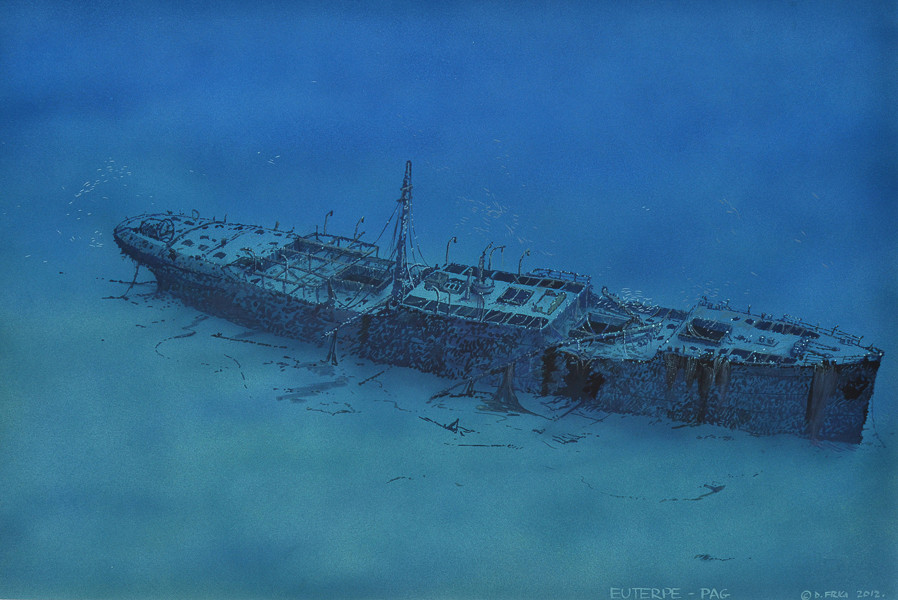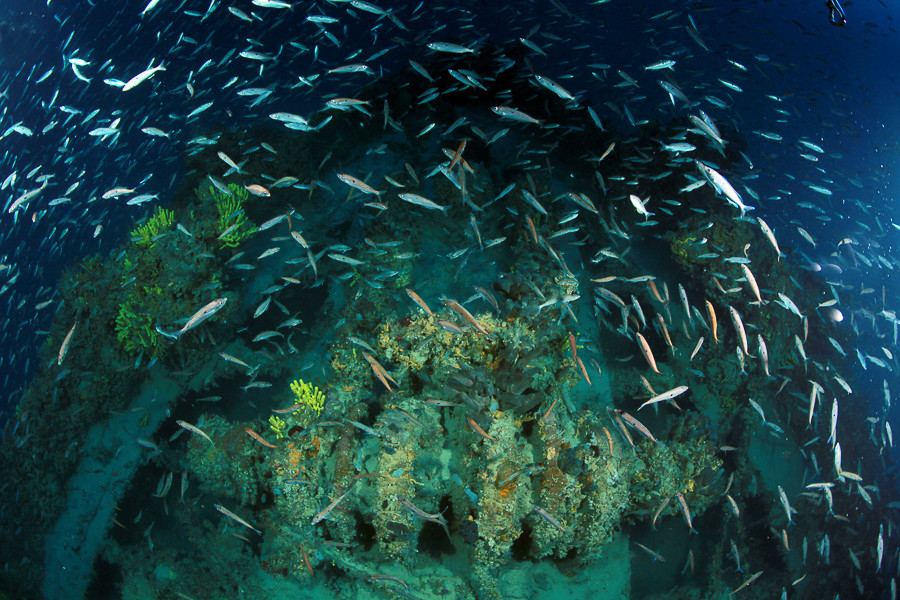
EUTERPE
DEPTH: 70 - 79 m
SKILL: Expert
Euterpe; steamship; Austro-Hungary, Österreichischer Lloyd Company
Built: 1886 J.L. Thompson & Sons, Sunderland, Great Britain.
Sunk: 11th August 1918 (torpedoed by Italian submarine F-7)
Dimensions: l=96.54 m, w=11.26 m, h=7.2 m, 2,302 GRT, 1,392 NRT
Coordinates: 44.60667° N, 14.79430° E
Location: west of the cove of Dubac on Pag
Access: 1/5 access is solely by boat (the location is in the open sea)
Visibility: 3/5 variable, occasionally very good visibility
Current: 4/5 weak, only occasionally moderate
Flora and fauna: 5/5 varied life on and around the wreck, on the wreck large specimens of fish
HISTORY:
The Euterpe was built in 1886 in the J.L. Thompson & Sons shipyard, in the city of Sunderland in the North East of England. It was a large cargo-passenger steamship which the Austrian Lloyds Company ordered during a time of great expansion in trade and maritime passenger transport. The passenger rooms were situated at the fore, middle and aft sections, whilst in between them were situated the spacious cargo holds. The steamship sailed the Levant sea route until the outbreak of the First World War. After the war broke out, the ship was sent for decommissioning, so that in March 1918 it was leased to the Command of Maritime Transport in Rijeka. In May the ship was equipped, and from 25th June is sailed the long coastal route Rijeka-Bay of Kotar (Boka Kotorska).
However the Euterpe did not serve long in military service. On the night of the 11th August 1918 about 1945 hrs., when it was about 1.5 nm from the cove of Dubac on Pag, it was torpedoed by the Italian submarine F-7 with two torpedoes, of which only one actually exploded. The weather was bad, with huge waves, and the struck ship quickly began to list. On it, besides the crew, were about 1,000 Austro-Hungarian soldiers, who were situated in the cargo holds organised into improvised sleeping quarters. The explosion destroyed the shortest exit to the deck from one cargo hold, from which only a small number of soldiers managed to be saved. In just a few minutes the ship disappeared from the surface, where a large number of survivors were left to swim. The escorting ships – the SMS Magnet and torpedo boats 55 and 64 rescued about 450 people, whilst 453 soldiers and 11 crew members sank with the ship (some sources quote that 555 soldiers were killed). The sinking of the steamship Euterpe is considered to be one of the greatest maritime tragedies which happened during the First World War in the Adriatic.
WRECK CONDITION AND DIVING:
The undersea world of Kvarnerić hides a number of sunken ships which perished during the First and Second World Wars. Due to the great depths and locations of the sinkings, which are far from the coast, the locating and identification of the sunken ships were only made in the late 1990’s.
The wreck of the steamship Euterpe rests on a flat muddy-sandy bottom at a depth of 79 metres. Descending to the wreck, with good visibility at just fifty metres deep its large hull with its large forecastle, central and aft superstructure can be discerned. The stern of the ship was quite badly destroyed and parts of it lie on the seabed around the wreck. On the upper stern section is a low aft superstructure inside which is a large area open in the form of a restaurant hall and here it is possible to peer inside, although descending down through it to the lower deck is not possible due to very large deposits of silt.
The central superstructure is very overgrown with crustaceans, sponges and algae and it is difficult to enter its interior because of the thick layers of dead crustaceans. These deposits are especially high in the side aisles under the port and starboard sides of the superstructure, and the free space to the ceiling totals only 40-50 cm.
The deck in front of the central superstructure shows signs of the torpedo’s explosion: bent sheet metal and steel beams bare witness to its destructive power. Here is also the entrance to the cargo hold, in which the Austro-Hungarian soldiers perished. However in the hold it is not possible to notice any trace reminiscent of the past tragedy - the mortal remains of hundreds of soldiers, their weapons and equipment rest forever under thick layers of silt. With the force of the explosion, the foremast collapsed and it now lies, leaning with one section on the bottom, and the other on the deck. The forward cargo hold of three decks is also empty, only mud can be seen on its floor.
The forecastle is congested with crustaceans and multi-coloured sponges however the passages to its interior are obstructed with the disintegrating parts of the bulkheads and steel beams.
The Euterpe today is just one of the many forgotten mass graves, a silent witness to the events of war on the Adriatic which diving enthusiasts rarely visit. It is a protected locality which technical divers can visit through an authorised diving centre, of which there are some on Pag close to the location.
The description and illustrations are a courtesy of Danijel Frka and Jasen Mesić. Buy the whole book here: https://shop.naklada-val.hr/product_info.php?products_id=561
Built: 1886 J.L. Thompson & Sons, Sunderland, Great Britain.
Sunk: 11th August 1918 (torpedoed by Italian submarine F-7)
Dimensions: l=96.54 m, w=11.26 m, h=7.2 m, 2,302 GRT, 1,392 NRT
Coordinates: 44.60667° N, 14.79430° E
Location: west of the cove of Dubac on Pag
Access: 1/5 access is solely by boat (the location is in the open sea)
Visibility: 3/5 variable, occasionally very good visibility
Current: 4/5 weak, only occasionally moderate
Flora and fauna: 5/5 varied life on and around the wreck, on the wreck large specimens of fish
HISTORY:
The Euterpe was built in 1886 in the J.L. Thompson & Sons shipyard, in the city of Sunderland in the North East of England. It was a large cargo-passenger steamship which the Austrian Lloyds Company ordered during a time of great expansion in trade and maritime passenger transport. The passenger rooms were situated at the fore, middle and aft sections, whilst in between them were situated the spacious cargo holds. The steamship sailed the Levant sea route until the outbreak of the First World War. After the war broke out, the ship was sent for decommissioning, so that in March 1918 it was leased to the Command of Maritime Transport in Rijeka. In May the ship was equipped, and from 25th June is sailed the long coastal route Rijeka-Bay of Kotar (Boka Kotorska).
However the Euterpe did not serve long in military service. On the night of the 11th August 1918 about 1945 hrs., when it was about 1.5 nm from the cove of Dubac on Pag, it was torpedoed by the Italian submarine F-7 with two torpedoes, of which only one actually exploded. The weather was bad, with huge waves, and the struck ship quickly began to list. On it, besides the crew, were about 1,000 Austro-Hungarian soldiers, who were situated in the cargo holds organised into improvised sleeping quarters. The explosion destroyed the shortest exit to the deck from one cargo hold, from which only a small number of soldiers managed to be saved. In just a few minutes the ship disappeared from the surface, where a large number of survivors were left to swim. The escorting ships – the SMS Magnet and torpedo boats 55 and 64 rescued about 450 people, whilst 453 soldiers and 11 crew members sank with the ship (some sources quote that 555 soldiers were killed). The sinking of the steamship Euterpe is considered to be one of the greatest maritime tragedies which happened during the First World War in the Adriatic.
WRECK CONDITION AND DIVING:
The undersea world of Kvarnerić hides a number of sunken ships which perished during the First and Second World Wars. Due to the great depths and locations of the sinkings, which are far from the coast, the locating and identification of the sunken ships were only made in the late 1990’s.
The wreck of the steamship Euterpe rests on a flat muddy-sandy bottom at a depth of 79 metres. Descending to the wreck, with good visibility at just fifty metres deep its large hull with its large forecastle, central and aft superstructure can be discerned. The stern of the ship was quite badly destroyed and parts of it lie on the seabed around the wreck. On the upper stern section is a low aft superstructure inside which is a large area open in the form of a restaurant hall and here it is possible to peer inside, although descending down through it to the lower deck is not possible due to very large deposits of silt.
The central superstructure is very overgrown with crustaceans, sponges and algae and it is difficult to enter its interior because of the thick layers of dead crustaceans. These deposits are especially high in the side aisles under the port and starboard sides of the superstructure, and the free space to the ceiling totals only 40-50 cm.
The deck in front of the central superstructure shows signs of the torpedo’s explosion: bent sheet metal and steel beams bare witness to its destructive power. Here is also the entrance to the cargo hold, in which the Austro-Hungarian soldiers perished. However in the hold it is not possible to notice any trace reminiscent of the past tragedy - the mortal remains of hundreds of soldiers, their weapons and equipment rest forever under thick layers of silt. With the force of the explosion, the foremast collapsed and it now lies, leaning with one section on the bottom, and the other on the deck. The forward cargo hold of three decks is also empty, only mud can be seen on its floor.
The forecastle is congested with crustaceans and multi-coloured sponges however the passages to its interior are obstructed with the disintegrating parts of the bulkheads and steel beams.
The Euterpe today is just one of the many forgotten mass graves, a silent witness to the events of war on the Adriatic which diving enthusiasts rarely visit. It is a protected locality which technical divers can visit through an authorised diving centre, of which there are some on Pag close to the location.
The description and illustrations are a courtesy of Danijel Frka and Jasen Mesić. Buy the whole book here: https://shop.naklada-val.hr/product_info.php?products_id=561








 The investment is co-financed by the Republic of Slovenia and the European Union from the European Regional Development Fund.
The investment is co-financed by the Republic of Slovenia and the European Union from the European Regional Development Fund.  H2O Globe BETA
H2O Globe BETA